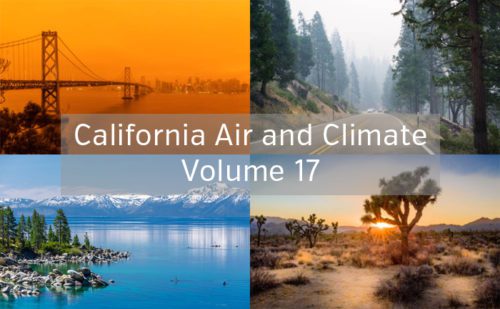California Air and Climate: CARB Expands Emissions Reporting Requirements and Considers Indoor Gas Appliances; SJVAPCD Pursues Additional Reductions from Glass Furnaces, Stationary Engines, and the Oil and Gas Industry
December 2020
California Air and Climate, Vol. 17
California Air Resources Board Significantly Expands Air Emissions Reporting Requirements
On November 19, 2020, CARB amended its “Regulation for the Reporting of Criteria Air Pollutants and Toxic Air Contaminants” (CTR) and Emission Inventory Criteria and Guidelines Report for The Air Toxics Hot Spots Program. The current CTR was adopted in December 2018 and recently became effective in January 2020. This amendment will significantly increase the number of facilities subject to the reporting requirements from 1,300 to over 60,000, over a multi-year phase-in schedule, from 2023 through 2028. All facilities that are permitted by a local air district and emit at least four tons per year of a criteria air pollutant will be subject to the reporting requirements, as well as additional facilities emitting air toxics. CARB claims that approximately 40 percent of the facilities (24,000) will be subject to an “abbreviated” reporting program. The amendments will also add about 800 chemicals to the current list of 450 air pollutants that must be reported.
CARB adopted the amendments despite comments from industry and the air districts tasked with compiling the data that the amendments are onerous and costly. In addition, facilities will be required to report emissions of hundreds of chemicals that do not have published toxicity factors, lab analysis procedures or source test methods.
CARB indicated that it plans to propose additional amendments to ease the reporting burden.
More information on the CTR Amendments are found here and the Hot Spots amendments are found here.
California Air Resources Board Adopts Groundbreaking Resolution to Reduce Emissions from Gas Appliances in Buildings
On November 19, 2020, CARB adopted Resolution No. 2-32 to promote the reduction of emissions from gas appliances in buildings, which appears to be one of the first of its kind. Since at least 2005, CARB has studied the impacts of indoor air pollutants such as nitrogen dioxide (NO2) from indoor sources like gas appliances on human health and the environment. According to CARB, Californians spend an average of 87 percent of their time indoors and exposure to indoor air pollutants contributes to various health risks including cancer, premature death, asthma, and other respiratory or cardiovascular diseases. Resolution No. 2-32 directs staff to take five main actions: (1) work with other agencies, including the California Energy Commission, to support building code updates for stronger kitchen ventilation standards and the electrification of appliances, including stoves, ovens, furnaces, and space and water heaters; (2) support the development of rules and best practices to reduce nitrous oxide (NOx) and other harmful appliance emissions, and promote the electrification of appliances; (3) expand CARB’s work to understand and study various issues tied to indoor air pollution; (4) promote community involvement on CARB’s efforts to research indoor air quality and exposure assessments; and (5) develop indoor air quality guidance documents to help reduce health impacts from pollution exposure.
For additional information about CARB Resolution No. 2-32, please click here and here.
San Joaquin Valley Air Pollution Control District to Consider More Stringent Rules for Glass Melting Furnaces, the Oil and Gas Industry, and Stationary Engines
The San Joaquin Valley Air Pollution Control District (SJVAPCD) has commenced the rulemaking process to amend its rule regulating glass melting furnaces, a series of rules regulating oil and gas facilities, and stationary internal combustion engines.
Glass Melting Furnaces – SJVAPCD plans to review Rule 4354 and consider options to reduce NOx, SO2, and PM emissions. Revisions are required under SJVAPCD’s PM 2.5 attainment plan (NOx and SO2 are PM2.5 precursors). There are currently six facilities operating as glass melting furnaces in SJVAPCD including facilities producing containers (e.g., wine and beer bottles), fiberglass, and float glass (e.g., windows). SJVAPCD will consider control technologies including oxy-fuel, ceramic catalytic filters, and selective catalytic reduction to achieve reductions in addition to the 70-80% NOx reductions mandated under the current rule.
Additional information is available here.
Oil and Gas and Related Industries – SJVAPCD will hold a workshop on December 11, 2020 to discuss proposed amendments to five rules regulating emissions from oil and gas sources including steam-enhanced oil wells (Rule 4401); components at crude oil production facilities and natural gas production and processing facilities (Rule 4409); components at petroleum refineries, gas liquids processing facilities, and chemical plants (Rule 4455); storage of organic liquids (Rule 4623); and transfer of organic liquids (4624). These rules are being examined as part of the AB 617 requirement to enact Best Available Retrofit Control Technology (BARCT).
Additional information is available here.
Stationary Engines – SJVAPCD has published draft amendments to Rule 4702, which would mandate additional emission reductions from stationary internal combustion engines. The proposed reductions, in accordance with SJVAPCD’s PM 2.5 attainment plan, will require additional NOx reductions from spark and compression ignited engines above 25 horse power, which are typically used to operate generators, pumps and compressors. SJVAPCD has requested comments on the proposed regulation by December 29, 2020.
Additional information is available here.

